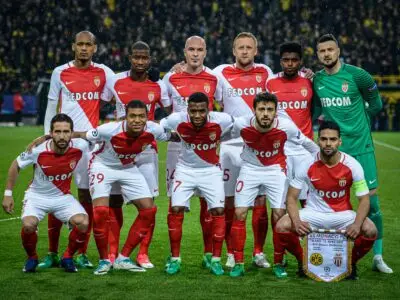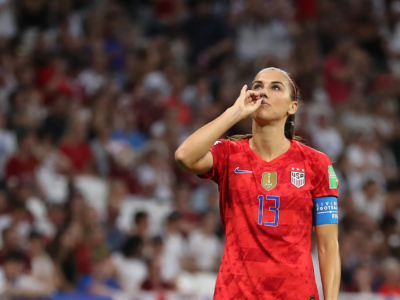As a young adult, I remember the palpable vitriol and masked hate for women’s football.
My micro-SD card contained highlights of Ronaldo (R9), Ronaldinho, and Jay Jay Okocha. But somewhere tucked into the “funny videos” folder was an epic fail compilation video from women’s football.
Today, my students watch Alexis Putellas’s skill compilation and argue whether Marta or Alex Morgan is the “GWOAT” footballer.
It shames me but warms my heart how far the women’s game has come. Even with all the naysayers, it is time to explore the tumultuous rise of women’s football.
The early days of women’s football
While women’s football matches today are fast-paced and captivating, their humble beginnings were unique for different reasons — resilience and a deep love for the sport. And that is because, before 1921, football was a man’s game in every sense of the word.
Although history suggests women have participated in the beautiful game from its inception, women’s association football was often seen as a curiosity. With small groups forming teams and playing for charity events, the ladies were the side attraction.

Then, the First World War hit, and suddenly, women’s football gained momentum. Factory workers took to the pitch in their free time — a distraction from the ravages of war was more than welcome.
What was once trickles of families and friends turned into crowds by the thousands. For every cynic who thought women’s football was not entertaining, the 53,000 spectators at Goodison Park in 1920 would argue against it.
However, all happy endings start with a crown of thorns, and this blossoming sport would soon face its greatest challenge.
The success and popularity of teams like Dick, Kerr Ladies foreshadowed a coming storm; one that would test the perseverance and passion of women footballers worldwide. Little did they know that 1921 would bring a decision that would alter the course of their game for decades.
The 50-year ban
Just when women’s football was kicking off with real momentum, in 1921, the unexpected happened — a ‘red card’ from the Football Association. They deemed the game “unsuitable for females” and banned women from using FA-affiliated pitches. All the work of pioneers like Nettie Honeyball had come undone in a move that would sideline the sport for nearly 50 years.

Imagine being told to hang up your boots, not because of injury, but because someone decided the beautiful game wasn’t appropriate for you.
For half a century, women’s football was essentially shoved into the backroom of the sports world to pick up dust like an old broom. This sentiment cut across all sports, as seen in the case of Kathrine Switzer at the Boston Marathon.
Generations grew up without even knowing that women could play football. But the fact that you are now reading this article is proof that something has changed, and the spirit of football never died within women.
Resilient, they found parks, open fields, and wherever else they could to keep their passion alive. The FA would have to do more than ban these spirited ladies to make them take their eyes off the ball, and thankfully, they had reached the end of their legal sphere of influence.
So, the ladies waited for their moment to break through. And when that moment finally came, it was clear that the game had been waiting for its perfect comeback all those years.
The Roaring 70s
After the 1966 World Cup, people clamored for women to return to the big stage, which led to the creation of the Women’s FA in England three years later.
And what better way to kick off this new era than for the first Women’s World Cup tournament to be hosted in 1970? To make this iconic revenge dish even colder, the competition was run without — or possibly despite — FIFA.

The 1970s arrived, bringing with it a revival in women’s football that felt almost revolutionary. After nearly 50 years of being benched, women were finally allowed to lace up their boots and step back onto the hallowed turf. I imagine it felt like the whistle that had been silenced for decades suddenly shrieked back to life.
The ladies were never going to return quietly, and we are all glad that they didn’t! It was an explosion of energy, flair, and excitement. Much like the wave of African nations gaining independence in the 60s, the 70s signaled freedom for women’s football in many parts of the world. Barriers crumbled, and women everywhere were reclaiming their rightful place on the pitch.
The stadium lights were back on, and the beautiful game was beginning to look, well, a whole lot more beautiful. And the second Women’s World Cup saw crowds more than double the numbers Goodison Park boasted 50-odd years prior.
Much like any comeback story worth telling, this one was just in the opening credits, with much more drama, skill, and joy waiting in the wings — or so it seemed.
The slow pace of professionalization
As the decades passed, it became clear that while the game was back, the world wasn’t quite ready to treat it with the same seriousness as the men’s. Countries were slow to establish professional or even semi-pro leagues for women, and the idea of football as a career for women was still met with reluctance, confusion, or, worse, indifference.

France’s D1 Féminine, while being one of the stronger women’s leagues, began in 1992 but didn’t achieve full professional status until 2009. And if you think that was late, you better hold onto the seat of your pants!
In England, despite the long-standing passion for football, fans had to huff and puff until 2011, before the FA Women’s Super League (WSL) finally turned fully professional.
Even then, it was a gradual process, as players still had to juggle side jobs to make ends meet. Many believe this action of making the ladies pros was down to the optics the country wanted to have before the Summer Olympics kicked off on its soil.
Meanwhile, countries like Brazil and Italy also saw sluggish progress. Brazil, a footballing nation through and through, only professionalized women’s football in 2016, despite producing legends like Marta.
Spaniards saw the journey take even longer. La Liga F only officially professionalized in 2021, and not without serious labor disputes along the way. Spanish players, like their counterparts around the world, battled for fundamental rights like fair wages and working conditions, echoing a struggle familiar to women athletes everywhere.
It’s safe to say that if professionalization was a race, women’s football found itself waving at the horizon, wondering when it would finally catch up to the men’s game. It was and had always been a fight against inequality.
The battle for equality
The debate about equal pay in women’s football has been a fixture of the modern era, a contest every bit as fierce as any on-pitch rivalry.
While the crowds roar for more goals, women’s footballers have also been demanding something else: equal compensation for equal work. The way the athletes saw it, they could level the playing field, one goal at a time.
In the US, this battle has played out publicly, with the U.S. Women’s National Team (USWNT) at the center. Despite their consistent success in the form of multiple World Cups and Olympic golds, the USWNT earned far less than their male counterparts. But that seemed just as fair as a black bear in the dead of the night.
A landmark lawsuit in 2019, led by players like Megan Rapinoe, put the issue front and center. The argument was simple: if the women’s team is achieving more, bringing in crowds, and inspiring a generation, shouldn’t they receive the same pay as the men? The fight wasn’t just about money, though; it was a rallying cry for equality in the global game.

But, as with any worthwhile debate, there are those who argue the other side. Critics often point to revenue imbalances between men’s and women’s football as justification for the pay gap.
Think of the UEFA Champions League for men’s football, with its million-dollar TV deals and commercial sponsorships. It almost feels like a money-printing machine. Then think of the same competition for women—it just doesn’t have that same spark, right?
On the surface, that sounds like a solid argument, but here’s the catch — it’s a cycle. Without equal investment and exposure, women’s football can never grow to its full potential, making the argument self-perpetuating.
Football federations
The proverbial ball has been in the federations’ courts for years, and only now are they beginning to realize that investment breeds success, and success brings in revenue, which in turn fuels investments. Oh, this emotionless Ferris wheel that we call the business side of football!
Equal pay isn’t the only battle on the pitch, though. In many countries where women’s rights are decades behind men’s, equal opportunity for women’s football remains a dream. Iran and Saudi Arabia have seen women’s participation in sports struggle.

Despite some recent progress, many women in these regions still find themselves fighting just to have the right to play, let alone earn a living from football. So, for all the progress that we have made to bring women’s football across the finish line, there are ladies who are still at the starting line, yet to hear the referee’s gun.
Overcoming the “Boys’ Club” mentality
An even more common problem is what I call the ‘boys club mentality.” This is more of a mental challenge than a political one, which sounds both hopeful and grim at the same time.
This is evident with the absurd reaction of the Spanish Football President, Luis Rubiales, after the media called him out for kissing Jenni Hermoso without her consent on national TV.

A monumental achievement for Spanish women devolved into a media circus of misogynistic grandstanding and chest-thumping from all corners.
Influencers and icons in women’s football
From locker-room banter to fail compilations of female goalkeepers conceding contentious goals and snarky memes on Twitter, football conversations weren’t always kind to women’s football.
Each mistake is magnified, and each moment of imperfection turns into a viral punchline as if to suggest women belonged anywhere but on the pitch. The message was clear: women, it seemed, weren’t allowed to have an off day.
But like any underdog story, women in football didn’t retreat; they counter-attacked. Rather than shying away from the spotlight, some have embraced it, turning negativity into a platform.

Alisha Lehmann, pro footballer for Juventus, turned negativity into financial and personal wins, amassing 17 million Instagram followers on the way. She used social media clips of her taking on challenges and generally playing footie, especially while at Aston Villa, to boost her personal brand.
While some internet trolls may still have their jokes, Lehmann, now at Juventus, is the one laughing all the way to the bank. She and others like her are transforming their fame into sponsorship deals, endorsements, and a platform that empowers the next generation of female footballers.

Then there’s Alex Morgan, who endured jabs from British media houses until she struck back with her cheeky tea celebration after her goal against England.
Like Lehmann, Morgan (now retired) showed that women in football are rewriting the script. It’s not just about how well you play; it’s how you can turn the spotlight, even the harsh one, into an opportunity.
The USWNT as pioneers of the game
Champions on and off the field of play, few have flown the flag higher or louder than the U.S. Women’s National Team (USWNT).
Throughout the 2010s, they weren’t just winning on the pitch — they were creating an unstoppable movement that transcended sport. This team was my introduction to women’s football.
Abby Wambach, Alex Morgan, and Megan Rapinoe were figureheads in the USWMNT. But they transcended that and became more than just footballers; they became cultural icons, symbols of empowerment, and faces of a growing revolution in women’s football.
Wambach’s headers were almost as precise as her fierce leadership, and Morgan’s grace and precision in front of goal captivated fans.
And then you have Megan Rapinoe, whose clutch performances and outspoken advocacy for equality molded her into a symbol of defiance for women. The blue-haired skipper was focused and never backed down, even in the face of criticism from her own country’s president.
As divisive as her personality was, she was the inspiration for many young girls to kick a ball and really believe in their abilities to make it to the big stage.

And then there was her trademark celebration — a gesture that makes you nostalgic for that iconic “are you not entertained” scene from the classic movie The Gladiator. If social justice in Women’s football had a face, it would be Megan Rapinoe.
The modern era
I can still picture the UEFA Women’s Champions League Final in Kyiv from 2018 as if it were yesterday. The venue, Valeriy Lobanovskyi Dynamo Stadium, which can hold just under 17,000 people, is home to Dynamo Kyiv’s team B.
Two days later, in the same city, the men’s final took place in the state-of-the-art NSK Olympiyskiy stadium, which held 70,000 spectators under dazzling lighting befitting the biggest stages. It was a striking difference as if there were two distinct universes living in one city.
But after just a few years, that difference is starting to narrow — and rapidly! The Women’s Champions League final in 2024 drew 50,000 spectators, who packed the stadium to capacity, demonstrating the game’s explosive growth in popularity.
And who could forget Barcelona Femeni, who defied all predictions by drawing 91,648 spectators to the legendary Camp Nou?

It was more than simply a contest; it was a thunderous cheer for women’s football that had finally come from a global football audience. Moving forward, the goal of women’s football was to thrive rather than merely prove it belongs!
Women’s football is in good hands
Women’s football has an incredibly bright future ahead of it. Strategists like Emma Hayes and Sarina Wiegman, who meticulously shape teams with razor-sharp intellect, are at the center of this steady ascent.
The days of ‘just good enough‘ are long gone. These women are building not teams but dynasties. Then you have Laura Woods, Alex Scott, and Eni Aluko overrunning the punditry stronghold on the opposite side of the microphone.
Of course, there are always the sporadic protests from archaic figures like Joey Barton, whom no one really remembers. Their voices fade, too, like inconsequential whispers drowned by the unstoppable thunder of a sporting revolution.

Not to be overlooked are the symbols and myths whose mere names motivate whole countries. Asisat Oshoala, my comrade who is carrying African football on her shoulders; Saki Kumagai and Yasmeen Khair, who serve as reminders that this is a global game; Marta, who is, in my opinion, Brazil’s lifeblood and the greatest of all time; and Alexia Putellas, who is the heartbeat of Spain.
Football for women is no longer a comedic spectacle. With the spotlights on, it takes center stage and will only grow. This is a movement, not just a game!
Who wrote this?
Precious is a lover of football, a peddler of banter, the master of all sports, and the practitioner of none. He's spent over 15 years discussing football in pubs and schoolyards.























